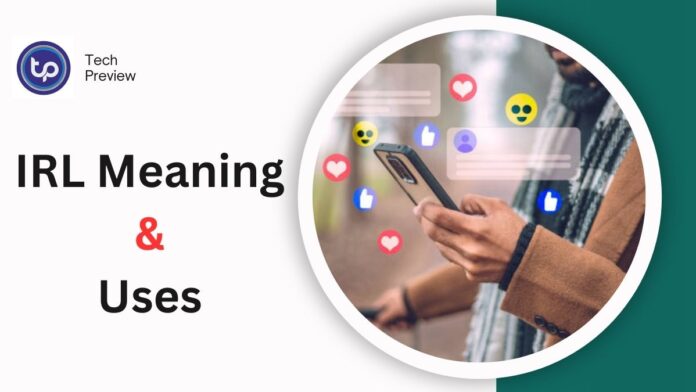In the digital age, communication has grown rapidly, and the language we use has also changed. One of the many abbreviations common in online conversations is “IRL,” which stands for “In Real Life.”
Initially used to differentiate between online interactions and face-to-face experiences, “IRL” has grown quite as digital and real-world experiences continue to twist.
This article will talk all about the meaning of “IRL,” its origins, different contexts of usage, and the broader importance of the term in today’s hyper-connected society.
What Does “IRL” Mean?
“IRL” stands for “In Real Life.” It is a term used mainly in online communications to distinguish between activities or interactions happening in the physical world versus those that occur virtually. When someone refers to doing something “IRL,” they are talking about engaging in activities outside the digital realm,whether it is meeting friends, attending events, or simply going about daily tasks.
The term is generally used across social media, gaming platforms, chat rooms, and in text messaging. It highlights the difference between online existence and the real, physical world where people can see, touch, and experience things directly.
Origins of “IRL”
The abbreviation “IRL” appeared in the early days of internet culture, around the 1990s, when online forums and chat rooms became popular. It was a way for users to specify that something discussed or planned would occur outside the virtual world. For example, gamers might say, “Let’s meet IRL,” to suggest gathering outside the game.
Over time, as digital interactions became a more dominant part of daily life, “IRL” gained broader usage, expanding from niche online communities to mainstream social media and everyday conversation. It reflects an ongoing societal trend where the boundaries between digital and real-life experiences are continually blurring.
Common Uses of “IRL”
The usage of “IRL” has evolved with the growth of digital communication. Here are some common contexts in which the term is applied:
- Social Media and Networking: On platforms like Twitter, Instagram, and TikTok, users often refer to “IRL” when they share content about their offline activities, such as travel, hobbies, or personal milestones. It indicates genuine life experiences from curated online personas.
- Gaming and Virtual Worlds: In gaming communities, “IRL” is often used to separate in-game actions from real-world plans. For instance, a player might discuss strategies or achievements in-game, then switch to talking about meeting teammates “IRL” for social gatherings or competitions.
- Professional Contexts: In business or work-related communications, “IRL” is sometimes used to explain that meetings or events will happen in person rather than via video calls or emails. This has become especially suitable in the context of remote work trends accelerated by the COVID-19 pandemic.
- Personal Interactions: People often use “IRL” casually to refer to face-to-face interactions, such as dating, hanging out with friends, or engaging in hobbies that require physical presence. It is a way to highlight the value of real-world connections over virtual ones.
Why “IRL” Matters in Today’s World
The importance of “IRL” extends beyond a simple abbreviation; it reflects deeper social dynamics and attitudes towards digital versus physical experiences.
As online interactions become more immersive and integral to everyday life, differentiating between the two realms can be important for keeping a balanced lifestyle.
- Maintaining Authenticity: In a world where much of our interaction happens through screens, “IRL” serves as a reminder of the importance of genuine, real-world connections. It enables people to step away from the digital noise and engage with the tangible aspects of life.
- Mental Health Considerations: Spending excessive time online can sometimes lead to feelings of isolation or detachment. Engaging in “IRL” activities is often recommended by mental health professionals as a way to foster meaningful relationships and improve overall well-being.
- Navigating Digital Identities: As people build online identities through social media, distinguishing “IRL” experiences helps maintain a sense of personal authenticity. It allows people to present a fuller, more nuanced version of themselves beyond the curated online persona.
The Impact of Digital Transformation on “IRL”
With the rapid advancement of technology, the line between digital and physical experiences continues to blur. Virtual reality (VR), augmented reality (AR), and the rise of the metaverse are expanding the concept of “IRL,” making it more complex to define.
- Virtual vs. Physical Presence: Technologies like VR and AR create immersive environments that mimic real-life experiences, challenging traditional notions of what constitutes “IRL.” For example, a virtual meeting with realistic avatars can feel just as genuine as an in-person one.
- The Rise of Hybrid Events: Many events now integrate physical and digital elements, such as concerts streamed live with in-person audiences, or conferences that offer both virtual attendance and physical networking opportunities. This hybrid approach reflects the evolving nature of “IRL” in modern life.
- Social Media Influences: Platforms like Instagram and TikTok have popularized trends where digital actions have real-world consequences, like viral challenges or meetups. As these platforms evolve, the interplay between online content and “IRL” actions continues to shape social behaviors.
The Future of “IRL”
Looking ahead, the concept of “IRL” will likely continue to evolve as technology advances and societal norms shift. Here are some trends that could shape the future of “IRL”:
- Greater Integration of AR/VR: As extended and virtual reality technologies become more mainstream, the difference between virtual and physical spaces will become increasingly nuanced. This could lead to new ways of thinking about “IRL” that incorporate virtual elements seamlessly into everyday life.
- Evolving Work Environments: With remote and hybrid work models becoming the norm, “IRL” will play a critical role in balancing professional and personal interactions. Companies may place greater focus on in-person connections to foster team cohesion and corporate culture.
- Increased Value on Offline Time: As digital exhaustion becomes more prevalent, there may be a cultural shift towards valuing offline time more highly. People might prioritize “IRL” experiences as a form of digital detox, seeking deeper connections and more meaningful engagements outside of their screens.
Conclusion
“IRL” or “In Real Life” is more than just a short form; it reflects the ongoing tension and balance between digital and physical worlds. As our lives become increasingly mediated by technology, the importance of maintaining a healthy relationship with both online and offline experiences cannot be overstated.
By understanding and appreciating the role of “IRL,” people can guide the digital age with a greater sense of authenticity, balance, and well-being.
Whether it is through meeting friends, pursuing hobbies, or simply stepping away from screens, the “IRL” moments are what ground us in reality and keep us connected to the essence of human experience.
To know more, click here.







